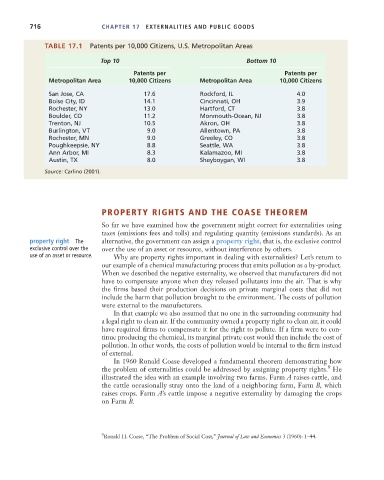Page 742 - Microeconomics, Fourth Edition
P. 742
c17ExternalitiesandPublicGoods.qxd 8/22/10 4:56 AM Page 716
716 CHAPTER 17 EXTERNALITIES AND PUBLIC GOODS
TABLE 17.1 Patents per 10,000 Citizens, U.S. Metropolitan Areas
Top 10 Bottom 10
Patents per Patents per
Metropolitan Area 10,000 Citizens Metropolitan Area 10,000 Citizens
San Jose, CA 17.6 Rockford, IL 4.0
Boise City, ID 14.1 Cincinnati, OH 3.9
Rochester, NY 13.0 Hartford, CT 3.8
Boulder, CO 11.2 Monmouth-Ocean, NJ 3.8
Trenton, NJ 10.5 Akron, OH 3.8
Burlington, VT 9.0 Allentown, PA 3.8
Rochester, MN 9.0 Greeley, CO 3.8
Poughkeepsie, NY 8.8 Seattle, WA 3.8
Ann Arbor, MI 8.3 Kalamazoo, MI 3.8
Austin, TX 8.0 Sheyboygan, WI 3.8
Source: Carlino (2001).
PROPERTY RIGHTS AND THE COASE THEOREM
So far we have examined how the government might correct for externalities using
taxes (emissions fees and tolls) and regulating quantity (emissions standards). As an
property right The alternative, the government can assign a property right, that is, the exclusive control
exclusive control over the over the use of an asset or resource, without interference by others.
use of an asset or resource. Why are property rights important in dealing with externalities? Let’s return to
our example of a chemical manufacturing process that emits pollution as a by-product.
When we described the negative externality, we observed that manufacturers did not
have to compensate anyone when they released pollutants into the air. That is why
the firms based their production decisions on private marginal costs that did not
include the harm that pollution brought to the environment. The costs of pollution
were external to the manufacturers.
In that example we also assumed that no one in the surrounding community had
a legal right to clean air. If the community owned a property right to clean air, it could
have required firms to compensate it for the right to pollute. If a firm were to con-
tinue producing the chemical, its marginal private cost would then include the cost of
pollution. In other words, the costs of pollution would be internal to the firm instead
of external.
In 1960 Ronald Coase developed a fundamental theorem demonstrating how
9
the problem of externalities could be addressed by assigning property rights. He
illustrated the idea with an example involving two farms. Farm A raises cattle, and
the cattle occasionally stray onto the land of a neighboring farm, Farm B, which
raises crops. Farm A’s cattle impose a negative externality by damaging the crops
on Farm B.
9 Ronald H. Coase, “The Problem of Social Cost,” Journal of Law and Economics 3 (1960): 1–44.

